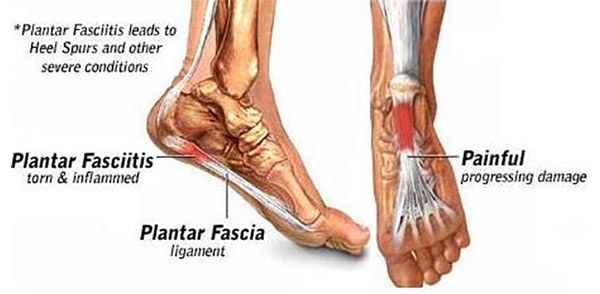What Causes Plantar Fasciitis

WHAT IS PLANTAR FASCIITIS? WHAT CAUSES PLANTAR FASCIITIS?
Plantar fasciitis is one of the most common diagnoses a podiatrist makes in his/her office when facing the common question “why do my heels hurt?” It is the inflammation of the plantar fascia. This inflammation is due to microtrauma to the area of the plantar fascia. This could be due to overuse and/or strain, flatfeet, or possibly a tight achilles tendon. When the foot flattens, the plantar fascia becomes taut, pulling at its insertion on the heel bone which causes pain. The plantar fascia originates from the bottom of the heel and divides into five slips, inserting into the five toes. The plantar fascia is also continuous with the Achilles tendon.
WHAT ARE THE SYMPTOMS?
Typically symptoms of plantar fasciitis are: pain with the first few steps in the morning or after a period of rest. As the condition becomes chronic, the pain becomes constant.
HOW DO YOU DIAGNOSE PLANTAR FASCIITIS?
Plantar fasciitis is diagnosed from different diagnostic modalities. X-rays are ordered to rule out any other pathology such as an obvious fracture. Other modalities that are used include ultrasound and MRI.
WHAT ARE PLANTAR FASCIITIS TREATMENTS?
Conservative Treatment
- RICE (rest, ice, compression, elevation)
- Anti-inflammatory medication (topical/oral)
- Physical therapy
- Night splint
- Low-dye tapping/strapping
- Orthotics
- Corticosteroid injection
Most patients become pain free with these above conservative measures.
Surgical Treatment
- In office Acell MatriStem/ PRP procedure
- Endoscopic plantar fasciotomy
- Plantar fasciotomy with Topaz & platelet rich plasma (PRP)
When conservative plantar fasciitis treatments fail, these are three options. Acell MatriStem is a xenograft that is obtained from pig tissue which is used in various surgical procedures. It maintains and supports a healing environment through constructive remodeling. This in office procedure consists of a minimal incision that is made on the side of the heel where Acell graft is then injected in the area of pain. This has been shown to help heal the micro trauma caused to the plantar fascia. Patients typically experience little to no discomfort afterward and can be weight bearing the day of the procedure in a surgical boot. This procedure is very similar to PRP (Platlet Rich Plasma) plantar fasciitis treatments, which are used worldwide to help treat soft tissue injuries with extensive literature showing great results.
Plantar fasciotomy with Topaz and PRP consists of placing tiny holes directly over the painful area. A radiofrequency “wand” is then introduced into these holes that ablate the fascia. This again stimulates an acute inflammatory response. Platelet rich plasma is then injected into the area, bringing nutrients that accelerate the healing response. The procedure is performed in an outpatient surgery center, takes about 15 minutes, and is minimally invasive.
Endoscopic plantar fasciotomy is also performed in an outpatient surgery center. The procedure takes about 10 minutes to perform and is also minimally invasive. A small incision is made on either side of the heel and the plantar fascia is cut. Patients may bear weight the same day. Success rates of 87% have been reported in the literature.



